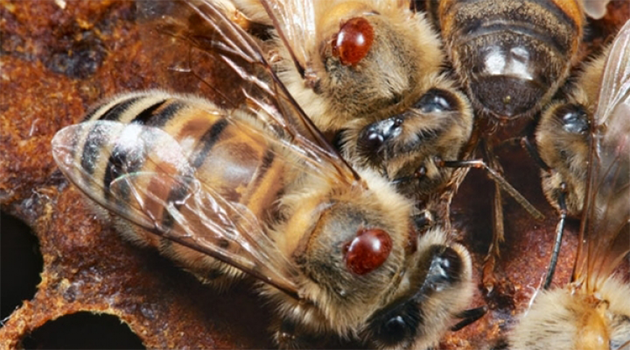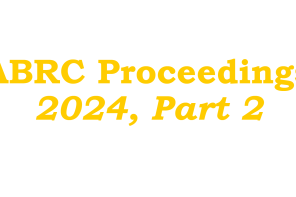By: Claudia Garrido
Thymol is one of the alternative treatments in late Summer, or even in Spring according to the temperatures of the year or area.
European beekeepers use thymol for several years, having three different registered treatments. For having best results by using thymol, some background knowledge is useful.
Like formic acid, thymol acts by its vapors. The bees distribute them in the hive by their activity, like ventilation or removal of the product. In addition, the external temperature is important: the efficacy is highest when the temperature ranges between 15-30°C (59-86°F) and never falls under 12°C (54°F). The ideal range for thymol treatments is 20-25°C (68-77°F). The most widely used and popular products all over Europe with thymol as a main ingredient are: Apiguard, ApiLifeVar and Thymovar. However, these products are not exactly the same: Apiguard is a gel with thymol, while the other two products are strips saturated with it. ApiLifeVar is a blend of thymol with eucalyptol, menthol and camphor, while Apiguard and Thymovar rely on pure thymol.
Comparison of the three products under different environmental conditions
Not many studies are available comparing the three products by means of their efficacy under different environmental conditions. The bee institute in Liebefeld (Switzerland) compared Thymovar and ApiLifeVar, finding high and similar efficacy for both products (around 90%).
A first extensive comparison of all three products was made in Italy: the scientists performed a study at three different locations in Northern, Central and Southern Italy. In the Centre and the South, all three products showed high efficacy, killing more than 90% of the Varroa mites in the colonies. In the North, however, Apiguard was less reliable. The efficacy dropped to 66.9%, which is insufficient for protecting bee colonies until the Winter treatment. The researchers attributed this low efficacy to the lower temperatures and low activity of the bees: under these circumstances, the workers did not “work” on the gel to remove it. By this, the gel surface dried, impeding the evaporation. The other two products did not have this problem.
In Germany, the same occurred: all three products were tested in Hesse (with cooler climate) and in the Rhine region (with milder climate). Apiguard in this trial had the lowest efficacy on both sites, with 43.1% in Hesse and 71.5% in the Rhine region. Thymovar worked better, though also this product was less efficient at the cooler site in Hesse. In the Italian study, Thymovar in addition also showed some problems in tolerability: the bees removed brood and honey from beneath the strips. In Northern Italy, the colonies decreased significantly in strength. At one of the two apiaries in this region, the study had to be interrupted because of the severity of the effects. This may have been due to a higher dose of thymol in Thymovar than in the other products and may have been released too fast. ApiLifeVar finally, was equally efficient at all sites and no problem with the safety for the bees happened. In the table below, you can find a summary of the results of these studies.
Product characteristics influence efficacy
In addition to the final efficacy, both studies measured the course of the efficacy during the treatment period, i.e. how fast the products kill most of the mites. Again, under the warm conditions in Central and Southern Italy, all three products reached many mites already in the first week. Under the cooler conditions in Northern Italy and Germany though, Apiguard started only very slow and killed only about 10% of the Varroa mites within the first week of the treatment. Thymovar and ApiLifeVar in this short period already killed 30-35% of the mites in Italy and 30-40% in Germany.
In this context, it is important to understand the conditions for treatment success with thymol. As already mentioned, this substance acts by its vapors. The concentration in the hive air must be high enough to kill the Varroa mites, but low enough not to harm the bees. This concentration ranges between 5-15 µg/l hive air. Tests in Switzerland showed that Apiguard, under cooler conditions, did not reach this therapeutic concentration. It remained under 4µg/l hive air, which explains the only low efficacy on cooler sites. Thymovar and ApiLifeVar on the other hand reached the therapeutic concentration already in the first week of the treatment. Interestingly, the hive air concentration decreased during this week in treatments with Thymovar, while it slightly increased using ApiLifeVar.
From all three products, ApiLifeVar was the most independent from environmental conditions. The efficacy remained over 90% at all sites. This may be due to the different composition of this product: differently to the other two, it is a blend of thymol with menthol, eucalyptol and camphor. An interesting property of this blend is that it remains liquid at colder temperatures. Pure thymol is solid until a temperature of 49-51°C (105-124°F), therefore also under hive conditions of 35°C (95°F). Mixing thymol with other aromatic substances decreases its melting point (i.e. when it becomes liquid). Both solid and liquid thymol can pass to the gaseous stage, which is necessary to reach the Varroa mites on the bees. However, the step from liquid to gaseous (evaporation) is much more constant and reliable than the step from solid to gaseous (sublimation), especially under cooler temperatures. This may be the explanation for the more consistently high efficacy of ApiLifeVar under cooler climatic conditions.
Some practical advice
When it is correctly used, thymol is a highly efficient and safe treatment against the Varroa mite. It is important to note that thymol does not reach reproducing Varroa mites in the brood and only kill the mites on the adult bees. Therefore, the duration of the treatment and any other indications given on the label are important to get the best results.
The details given above however show that a variety of factors influence the efficacy. Therefore, it is crucial to use registered products for Varroa treatments. Only these products were tested under different conditions and provide the data to make informed decisions about the right product to use. Other preparations do not offer this security: they may not have sufficient efficacy or the thymol concentrations in the hive air may get too high and harm the bees. Thymol is a natural substance, but as every medicinal or pesticide product, it has to be handled with care and responsibly.









